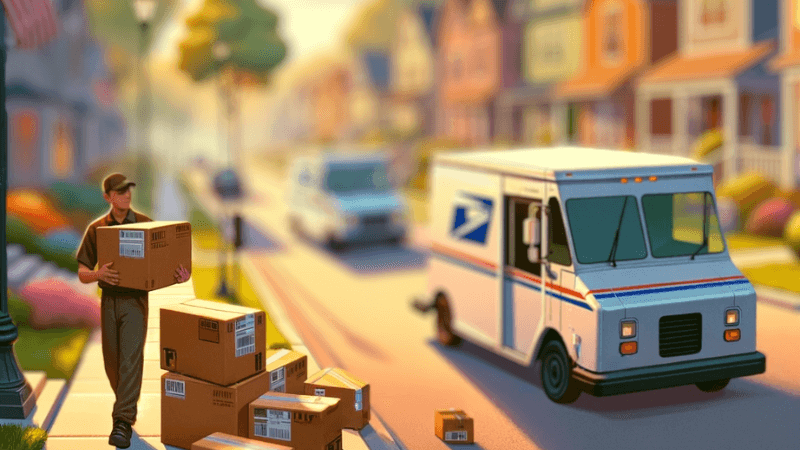Shipping costs can be a bit of a headache for eCommerce businesses, but opting to use flat rate shipping can help make things a bit more manageable. Flat rate pricing is far easier for both businesses and customers to wrap their heads around, and it’s a popular shipping method for all kinds of eCommerce businesses across the USA.
Today, we’re going to take a look at what flat rate shipping is, how it differs from standard shipping, the advantages and disadvantages of flat rate shipping, and under what circumstances flat rate shipping is a good solution.
In this article
What is flat rate shipping?

Flat rate shipping is a type of shipping where the price is determined by the packaging, such as the envelope or box, rather than the weight or dimensions of an item. This method standardizes shipping costs, eliminating the variations caused by different weights, dimensions, and delivery locations.
Flat Rate Shipping Time: How Long Does Flat Rate Shipping Take?
Flat rate shipping typically takes between 1 to 3 business days within the United States. Services like USPS Flat Rate Envelope, FedEx One Rate, and UPS Simple Rate offer expedited delivery options, ensuring quick and consistent transit times:
- USPS Flat Rate Envelope service (1-3 days)
- FedEx One Rate (1-3 days)
- UPS Simple Rate (1-3 days)
These services offer consistent shipping costs, regardless of the weight of the item as long as it fits within the specified dimensions.
Most carriers in the US provide flat rate shipping options alongside their priority mail flat rate, which are popular among eCommerce businesses for simplifying their shipping and fulfillment processes. These services cater to the diverse needs of businesses across the vast geographical landscape of the US, ensuring cost-effective and straightforward shipping solutions.
Flat rate shipping vs standard shipping
Flat rate shipping and standard shipping are commonly used terms in the shipping industry, and while they are often used interchangeably, there are significant differences between the two.
Price
As mentioned earlier, flat-rate shipping provides eCommerce businesses the ability to ship their products at a fixed price, as long as the package meets the weight and measurement requirements set by the courier service.
Different services offer various flat rate options. For instance, in the United States, USPS offers different flat rate boxes and envelopes, each with its own pricing. FedEx and UPS also provide similar flat-rate solutions, with their own sets of rules and pricing structures.
In contrast, standard shipping costs are calculated based on the weight, dimensions, and delivery location of the package. Seasonal variations may also influence these costs, particularly during peak shipping seasons
Delivery time
In the USA, flat rate shipping, including Priority Mail Flat Rate by USPS, offers standardized delivery times, usually ranging from 1-3 business days. This service provides a consistent and quick shipping option across various locations within the country. Priority Mail Flat Rate is particularly notable for its combination of speed and fixed pricing, regardless of package weight or destination within the United States.
While standard shipping, including services from UPS and FedEx, often has longer and more variable delivery times, it is more flexible for international shipments. For domestic needs, Priority Mail and Priority Mail Flat Rate by USPS stand out for their efficiency and cost-effectiveness, catering to those who need faster delivery without the uncertainty of variable shipping costs
Advantages of flat rate shipping
Simplifies the shipping process
Offering flat-rate shipping is much more straightforward for both eCommerce businesses and customers. With flat-rate shipping, you won’t need to spend excessive amounts of time working out different shipping costs, and you won’t have to bother with a shipping calculator.
All you have to do is decide which flat-rate services you want to use, and the job’s done. This gives you more time to grow your business, market your products, improve other areas of your supply chain, and so on. You can reinvest time making cost savings in other areas of your business.
Offers transparency to your customers
Fixed-rate shipping makes choosing an eCommerce shipping option more straightforward for your customers at PoS, removes unnecessary barriers, and provides an overall better online shopping experience. Furthermore, customers will appreciate the transparency in regards to cost and have peace of mind that there will be no additional shipping fees.
Reliable delivery times
When a customer selects a flat rate shipping option, they know how long it will take their order to arrive, regardless of how far away they are from the retailer’s warehouse or fulfillment center.
Disadvantages of flat rate shipping
You might not always get the best rate
Due to the standardized pricing of flat-rate shipping services, you may end up paying more for shipping than you need to.
For example, if you are shipping extremely small, light products, it could work out cheaper to send them standard as the flat-rate prices needs to account for heavier items.
Likewise, if you’re shipping in bulk, you might be able to get bespoke quotes by liaising with the carrier directly.
Can cause issues outside of your control
When people select a flat-rate shipping method, they expect to receive their order within the estimated timeframe. Delays happen, and most of the time that’s outside of your control. Still, this can result in frustrated customers, so it’s important to make them aware of potential delays at the earlier opportunity.
When to use flat-rate shipping
Flat-rate shipping works best when you sell a lot of products with the same or very similar weights and dimensions.
This means you can pick the most cost-effective flat-rate shipping option without needing to worry about certain products not being eligible. You can use flat-rate boxes and packaging as long as they comply with weight limits, and offer fixed prices to your customers.
You should also use flat-rate shipping if you want to save time. It’s a simple and convenient way to handle shipping, and that time can be spent improving other elements of your operation.
It’s also a good idea to use flat-rate shipping if you’re distributing orders from a single location. This will remove the surcharges and other shipping costs associated with moving goods between zones.
When to avoid using flat-rate shipping
As mentioned earlier, flat-rate shipping isn’t going to be cost-effective if you’re shipping a large number of small, light products, as you’ll end up paying for weight you aren’t using. You’ll be better served looking into standard shipping rates so you can calculate shipping costs for a bespoke solution.
Furthermore, if you’re shipping products a short distance, using local or short-range courier services could provide more competitive shipping prices.
Finally, a flat-rate service might not be suitable if you want to use your own packaging. While you can spend time and resources designing your custom packaging to meet courier standards, you may feel it’s more suitable to spend these resources elsewhere.
Want help with flat rate shipping strategy? Speak to James and James Fulfilment

James and James are an eCommerce fulfillment service with facilities in the USA but also the UK, EU, and Australia. We combine fantastic customer service with award-winning fulfillment technology (built by us!) to offer industry-leading speed and accuracy in the world of order fulfillment.
We ship thousands of products every week, and so we know a thing or two about the best shipping policy template and strategy for your eCommerce business.
We have a large network of courier partners and a variety of flat rate options, reduced shipping charges, and all the tools eCommerce brands need to make flat rate shipping work.
If shipping or general order fulfillment is giving you a headache or taking up too much time, it might be worth considering outsourcing to 3PL solutions like James and James. Our fulfillment centers are optimized for eCommerce businesses looking to grow and who ship lightweight products.
Getting started with us is super simple:
- Firstly, we’ll get to know your business and design a bespoke fulfillment solution for you
- Then, you’ll send your goods to us, where we’ll label them, and keep them safe and secure in our warehouse
- Once an order is placed, we’ll pick the right items, pack it in the most suitable packaging, and pick the most cost-effective shipping method to get it where it needs to be.
- If a customer wants to return a product, we’ll handle that too.
- Rinse and repeat. And while we take of the order fulfillment process, you can get on with growing your business!
To learn more about our shipping solutions and fulfillment service, get in touch today.
Flat rate shipping FAQs
What is the cheapest way to ship?
There’s no black and white answer to this, unfortunately. It’s always going to depend on what products you are shipping, quantities, weights and dimensions, and the destination that the goods are going to be shipped to.
Generally speaking, you can consider flat rate options available, e.g. USPS Flat Rate boxes or UPS flat rate packaging, which can be more economical for certain weights and sizes
Shipping needs differ from business to business, and there are always other factors to consider.
Does flat rate shipping have tracking?
Yes, all major couriers, including USPS with Priority Mail Flat Rate and UPS, provide tracking labels for flat rate packages, ensuring transparency and security in delivery.
Does order fulfillment include shipping?
Yes, shipping is often seen as the final stage of the order fulfillment process. Unless a product is defective or a customer decides to return a product, the fulfillment process is complete when the parcel is delivered to the customer.
What is the difference between fulfillment and shipping?
As highlighted above, shipping is just one aspect of the fulfillment process. The fulfillment process also includes warehouse storage, picking orders, packing them, and then processing returns if necessary.
How do shipping zones affect flat rate shipping?
Additional costs kick in for packages shipped outside of one shipping zone. The further the shipping zones is away from your location, the higher the shipping cost will be. Shipments within the same zone will always be the same price, whereas other zones will have different flat rates depending on where you’re shipping from.
Is flat rate shipping safe?
Yes, flat-rate shipping is safe. It offers transparency to customers regarding costs, ensuring there are no additional shipping fees. Moreover, major couriers provide flat-rate shipping options, and they are commonly used by eCommerce businesses aiming to simplify their shipping options and fulfillment process.
Is flat rate shipping faster?
Flat-rate shipping typically has a standardized delivery time. For instance, flat-rate shipping methods often have an estimated delivery time that specifies the expected number of days for an item to be delivered, such as 1-3 business days. It provides customers with a clear idea of how long it will take for their order to arrive, irrespective of their distance from the retailer’s warehouse or fulfillment center.
Are flat rate boxes cheaper?
The cost-effectiveness of flat-rate boxes depends on the specific circumstances. Flat-rate shipping allows businesses to ship products at a fixed price as long as they meet the weight and measurement requirements of the courier service. However, for extremely small, light products, it might be more economical to send them via standard shipping. On the other hand, for products with similar weights and dimensions, flat-rate shipping can be more cost-effective.
Can I use my own packaging for flat rate shipping?
While you can use your own packaging for services like USPS Priority Mail, standard flat rate boxes and envelopes provided by couriers like USPS and UPS are designed to fit within their specific flat rate shipping requirements.
Are there any restrictions on what can be sent via flat rate shipping?
Yes, depending on the courier, mailing restrictions apply to flat rate shipping. Items like hazardous materials and certain board games due to their dimensions may not be eligible for flat rate options. Get in touch for more information.

